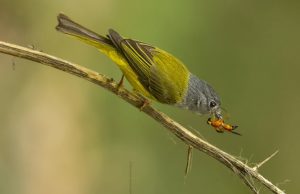
Grey-headed Canary Flycatcher Culicicapa ceylonensis
Etymology :
- Culicicapa : Latin word culicis-midge; capere – to seize
- Ceylonensis : From Ceylon , modern Srilanka
Vernacular Names : Ben: Zard-phutki, Guj: Rakhodi pilo makhimar, Tharvariyo makhimar, Mal: Narayanapakshi, Mar: Rakhi Dokyachi Pivali Mashimar
Distribution in India: Breeds in Himalayas , Resident in South West India and Winter visitor in Himalayan foothills, Central, North, East and North East India.
Description: Size of 12-13 cm. It is a small to medium-sized, slender, upright forest flycatcher with crested head shape. Nominate race has head to nape, side of neck and upper breast plain smoky grey, forehead and lores sometimes streaked darker, narrow white eyering; upperparts mostly greenish or yellowish olive-green ,brighter on rump and uppertail-coverts; upperwing-coverts as mantle and back, with yellowish edges of greater coverts, flight-feathers and tail feathers, inner webs of remiges and rectrices black; breast to undertail-coverts bright yellow, with olive on side of lower breast and flanks; iris dark brown; bill black, pinkish base of lower mandible; legs light brown to yellowish or pinkish-brown. Sexes are alike in plumage, female smaller than male. Frequently flicks tail when perched. Found during breeding in dry broadleaf forests and woodlands, favoring wooded gorges and ravines with streams; also abandoned plantations and large gardens; from lowlands to upper montane levels. In non-breeding season in similar habitat at lower levels, below 1000 m; also in smaller woodlands, sholas, bamboo forest, copses, mangrove forests, orchards and large wooded gardens.
Food Habits: It eats small gnats and mosquitoes, other dipteran flies, also beetles, wasps, moths and other small invertebrates. In pairs, solitary, or as regular member of mixed-species foraging flocks; in family parties in breeding season, and in non-breeding season several congregate in communal feeding area. It is tame, confiding and active throughout day. It forages at all levels down to understorey, usually within canopy, actively flitting between branches, vines and foliage; also pursues insects in acrobatic dashes within and above canopy and from lower prominent perches, often returning to same or nearby perch. It is territorial also in non-breeding season, and often aggressive towards conspecifics.
Breeding Habits: They breed in Feb-July in India. They are monogamous; pair-bond long-lasting. Displaying male performs short circling flights in front of perched female, perching adjacent to her and then flying off again, also hovering on rapidly vibrating wings in front of her and displaying rump, the two calling to each other throughout, and display repeated up to 15 times; male also courtship-feeds mate. The nest built entirely by male. It is a cup of moss, plant fibers, lichens and gossamer, material usually matching that of nest location, nest thus well camouflaged, usually placed on side of tree trunk, or on boulder. They lay two broods, often in same nest, or nest re-used in subsequent year. In each brood they lay a clutch 3–4 eggs. The male assists with feeding of nestlings.